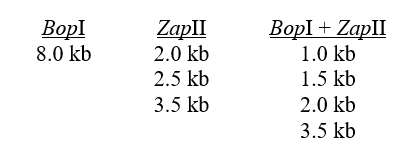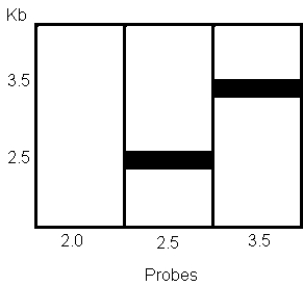A chimeric plasmid contains vector DNA ligated to a fragment of chromosomal mouse DNA that is suspected of containing the obese gene.As a first step,a restriction map of the DNA clone was constructed.The DNA was digested with two restriction enzymes,BopI and ZapII,with the following results:
a)From these data,answer the following questions.
(1)How large is the entire DNA clone?
(2)Is the clone linear or circular?
(3)Draw a restriction map consistent with these data.Include all BopI and ZapII sites and the physical distances between them.
b)To better identify the location of the mouse chromosomal DNA on this chimeric plasmid,mouse genomic DNA was digested with ZapII,run on a gel,and analyzed using the Southern blot technique.The Southern blot was probed with radiolabeled Zap II DNA fragments from the plasmid DNA.Three lanes each containing the same amount of Zap II-digested chromosomal DNA were each probed with a different fragment from the plasmid.Autoradiograms showed the following: What is the maximum amount of mouse DNA present in the clone? Why didn't the 2.0-kb ZapII fragment hybridize to the mouse DNA? 
Definitions:
Peremptory Challenge
A right in jury selection for attorneys to reject a certain number of potential jurors without stating a reason.
Challenge for Cause
A reason given in court for requesting the disqualification of a juror from a trial due to a specific reason, like bias or personal interest.
Affirmative Defense
A response to a plaintiff's claim which, if proven, diminishes or eliminates liability.
Summons
A legal document issued by a court that orders an individual to appear before it at a specific time and place to respond to a legal action or proceeding.
Q1: The class of genes required that act
Q3: Arabidopsis thaliana is a diploid plant model
Q4: A bacterial chromosome has four markers,A,B,C,and D,evenly
Q8: A maize plant is homozygous for an
Q12: The following table contains statements pertaining
Q23: A Drosophila researcher recently isolated a number
Q24: Two albino strains of Neurospora are crossed.Of
Q31: Telomeres have been a recent focus in
Q41: A Str<sup>R</sup> mutant:<br>A)can grow in the presence
Q55: In the bacteriophage <span class="ql-formula"